| dc.contributor.advisor | Markus Zahn and Bernard C. Lesieutre. | en_US |
| dc.contributor.author | Mamishev, Alexander V., 1974- | en_US |
| dc.date.accessioned | 2005-05-19T14:22:50Z | |
| dc.date.available | 2005-05-19T14:22:50Z | |
| dc.date.copyright | 1999 | en_US |
| dc.date.issued | 1999 | en_US |
| dc.identifier.uri | http://hdl.handle.net/1721.1/16729 | |
| dc.description | Thesis (Ph.D.)--Massachusetts Institute of Technology, Dept. of Electrical Engineering and Computer Science, 1999. | en_US |
| dc.description | Vita. | en_US |
| dc.description | Includes bibliographical references (v. 2, p. 677-704). | en_US |
| dc.description | This electronic version was submitted by the student author. The certified thesis is available in the Institute Archives and Special Collections. | en_US |
| dc.description.abstract | The major objective of this thesis is to develop instrumentation and parameter estimation algorithms for nondestructive measurement of non-homogeneous material property profiles with fringing electric field dielectrometry sensors. The instrumentation includes interdigital sensors and sensor arrays, other types of fringing field sensors, electronic circuit boards for measurement of sensor signals, and mechanical setups for specific applications. The parameter estimation algorithms require solving forward and inverse problems of material property estimation. The forward problem implies calculation of the sensor admittance matrix as a function of geometry and material properties. The inverse problem, inherently more difficult than the forward problem, implies estimation of unknown geometry and material properties based on known properties and measured entries of the sensor admittance matrix. The developed instrumentation and algorithms are applied to practical problems which include mo++ | en_US |
| dc.description.abstract | nitoring of moisture dynamics in transformer pressboard, evaluation of the saturation state of chemical garments, detection of flaws in fiberglass flywheels, and detection of buried metal and plastic landmines. The design strategy and fabrication practices are described for multiple penetration depth interdigital sensors designed for measurement of conductivity and permittivity of electrical insulation of power transformers. An extensive overview of interdigital electrode technology in other fields is given. A number of disturbance parameters that affect interdigital dielectrometry measurements is characterized and either eliminated or accounted for using empirical, analytical, and numerical simulation approaches. A new type of fringing field sensor has been developed to improve the cross-correlation between different fringing field patterns. In most cases, the forward problem has been solved using commercial finite-element software "Maxwell" by Ansoft Corp. Other methods, such as a co++ | en_US |
| dc.description.abstract | ntinuum model, analytical expressions, and direct calibration were used for comparison and to achieve greater accuracy in simple cases. A family of algorithms for solving inverse problems has been developed to address different applications. | en_US |
| dc.description.abstract | (cont.) No single algorithm provides the most accurate and reliable results in all cases. The most appropriate algorithm for each given application should be chosen on the basis of required speed and accuracy, number of known and unknown parameters, type of distribution of material properties, contact conditions between the sensor head and the material, and a specific type of sensor selected for the task. Major types of property estimation algorithms include direct calibration; use of empirically and numerically determined approximations; use of pre-computed lookup tables; iterative guesses at dielectric and geometry properties while solving the minimization problem of matching theoretical and measured entries of sensor admittance matrix; direct mapping between the sensor output and the physical variable of interest (not necessarily a dielectric property); | en_US |
| dc.description.abstract | (cont.) pattern recognition in the dielectric spectroscopy signature; and search for signal characteristics in the sensor output due to material property variations. Each of these major types of algorithms has been implemented in one or more forms to achieve the desired results for each specific problem. One of the algorithmic approaches has been generalized to other types of problemsby implementing it as a generic optimization tool. Moisture dynamics in transformer pressboard has been studied extensively with numerical simulations of the forward and inverse problem. The developed algorithm has been applied to experimental dataobtained by another graduate student, Yanqing Du, in a concurrent Ph.D. thesis. It has been demonstrated that a three-wavelength interdigital sensor can be used to measure time-dependent continuous smoothly varying moisture profiles in oil-impregnated power transformer pressboard. Ultimately, this technology is capable of preventing partial discharges and transformer failures due to flow electrification and static charging of the oil-pressboard interface. Preliminary measurements also demonstrated adequate sensitivity and selectivity of fringing field sensors for the detection of flaws in fiberglass flywheels and detection and discrimination of buried plastic and metal landmines. The saturation state of chemical protective garments hasbeen determined for relatively high levels of saturation. Additional work is needed to improve sensitivity in the low saturation region. | en_US |
| dc.description.statementofresponsibility | by Alexander V. Mamishev. | en_US |
| dc.format.extent | 2 v. (709 p.) | en_US |
| dc.format.extent | 28339444 bytes | |
| dc.format.extent | 28339161 bytes | |
| dc.format.mimetype | application/pdf | |
| dc.format.mimetype | application/pdf | |
| dc.language.iso | eng | en_US |
| dc.publisher | Massachusetts Institute of Technology | en_US |
| dc.rights | M.I.T. theses are protected by copyright. They may be viewed from this source for any purpose, but reproduction or distribution in any format is prohibited without written permission. See provided URL for inquiries about permission. | en_US |
| dc.rights.uri | http://theses.mit.edu:80/Dienst/UI/2.0/Describe/0018.mit.etheses%2f1999-9 | en_US |
| dc.rights.uri | http://dspace.mit.edu/handle/1721.1/7582 | |
| dc.subject | Electrical Engineering and Computer Science | en_US |
| dc.title | Interdigital dielectrometry sensor design and parameter estimation algorithms for non-destructive materials evaluation | en_US |
| dc.type | Thesis | en_US |
| dc.description.degree | Ph.D. | en_US |
| dc.contributor.department | Massachusetts Institute of Technology. Department of Electrical Engineering and Computer Science | |
| dc.identifier.oclc | 43565023 | en_US |
